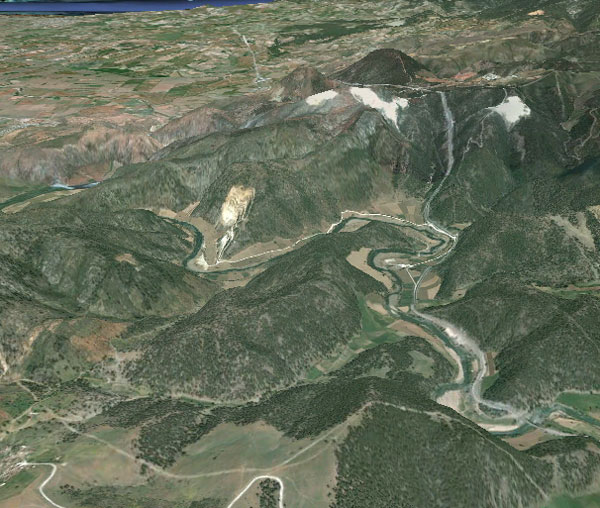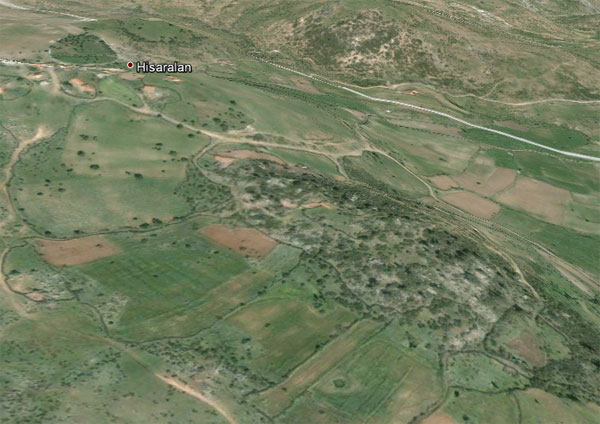Most archaeologists now agree that Hisarlik in northwest Turkey as discovered by Schliemann towards the end of the nineteenth century is the original Troy.
Although Hisarlik is undoubtedly Trojan is it really the actual Trojan city, its capital? Not really, Hisarlik means place of the fortress – a fortress not a city – it was simply a fortress (and surrounding settlement) that guarded the entrance to the river Scamander (on which Troy was situated). Google Translate translates Hisarlik as ‘fort’ and ‘of’, hisar meaning, fort, fortress, citadel, castle or tower but certainly not a city.
Apparently by the first century AD the location of Troy had been lost so there is no continuous tradition of exactly where it was (see the paragraph ‘The Rediscovery of Troy', note that I do not necessarily agree with everything on this website). It is a shame they didn't have Google Earth back then.
We have lost sight now of what an ancient city was, a place where people lived and worked, above all it was a place where you could live peacefully, where you could raise a family knowing they would be safe. Hisarlik is too near the sea at a time when pirates were known to have flourished, it has from the archaeological records suffered numerous fires and attacks (as you would expect from a fortress) hardly a safe place to raise your children.
The Walls of Troy
The walls of Troy were celebrated, they were supposed to have been built by master architects from Crete, something truly special, yet Hisarlik’s walls although impressive don’t appear to be anything special.
Travelling up the Scamander there is a ridge of hills - a superb natural defence that the Scamander runs through, any hostile ships would have to run the gauntlet through this narrow pass and there are numerous ancient remains on the tops of these hills suggesting they were strategically significant.

The Samander winding through the hills with the Plain of Troy
in the background
Passing through the gap in the ridge the landscape opens up in to a large ‘hidden’ valley, safe from pirates and full of signs of ancient habitation like the random checkerboard field patterns (reminiscent of British fields in fact). Close by is the modern town of Ezine which judging by its layout is obviously ancient as are many of the surrounding villages, eerily reminiscent of Britain too.
Overlooking this town is a steep flat topped hill which is known to be an ancient ruin but was never properly excavated by Schliemann and others at that time as it was then in bandit country and was unsafe for ‘westerners’. Many of its features are clearly visible on Google Earth including what look like zigzag shaped walls.

These zigzag markings are
very difficult to explain, mousing over will show the zigzags and the main
walls at the top
If these are walls then they are certainly more impressive than the walls of Hisarlik, these really could be the architect designed walls. Homer described the walls of Troy as ‘angled walls’, is this not a perfect description of them? The whole site including the old parts of the modern town would make a perfect Troy and would have been far more impressive than Hisarlik.
Archaeologists have identified this site with the ancient city of Neandreia, but this was not a Trojan city and if Hisarlik was an ancient fort it would have control of the Scamander and therefore trade from the seas, so the people living in Ezine are unlikely to have been a rival group of people as they would have been entirely dependent on the Trojans for trade. Also, Troy was the foremost city in the area, of world renown apparently, so how could Troy (as Hisarlik) be considerably smaller than Neander a rival but far less important city?
Of course this is only a theory and it is dependent on one thing being true that early small ships could trade directly with the original Ezine/Troy. According to Hilaire Belloc ancient ships could navigate in as little as three feet of water, therefore Troy being an inland sea port (not unlike London) certainly seems plausible. There is one odd thing about the Fall of Troy and that is why the Trojans did not try to retake Troy, they left en mass and their travels are well documented in the chronicles, so it could be that Troy was no longer viable. In the centuries before the Fall of Troy a new type of ship had been developed - the keeled ship and these presumably needed far deeper water making the port at Ezine redundant (where is the port or wharfs at Hisarlik supposed to have been?). What is more sailors used to complain that the prevailing winds forced them to stopover at Troy giving it a near monopoly and the source of its wealth but the new keeled shipscould sail against the wind by tacking and this perhaps allowed them to avoid having to trade with the overpriced Troy.
Unless Troy was a special exception then it ought to be similar to other ancient cities, most of these cities like London, Paris and even Babylon, which is older than Troy, are settlements on a river and are crossed by at least one important road by means of a bridge or ford. When Hisarlik was built it was at the mouth of the Scamander which was then far too wide to build a bridge or ford across, nor is there any evidence that there has ever been one. Only one road leads into Hisarlik, true cities have roads radiating out from them – it really isn’t a city. The siege of Troy lasted over ten years, it is extremely difficult to imagine how such a small and isolated settlement could have held out that long.
Finally if Hisarlik means fort then there is another fort to the east of Ezine which appears to be guarding a mountain pass, it is called Hisaralan which means the area of the fortress.

Hisaralan with what
looks suspiciously like a hill fort in ruins
To recap, this theory suggests that Hisarlik was part of the first defences of a Trojan homeland that stretched far further inland than is fully appreciated now and probably included the entire valley of the Scamander and its plains (with their distinctive ‘Celtic’ field patterns). That doesn’t mean to say that most of the battles did not take place on the Plain of Troy near Hisarlik as tradition has it but this was only the Trojans ‘front garden’ as it were, yet the main Trojan territory was behind the defensive line of hills and was vastly bigger with the modern town of Ezine its capital – the real Troy.
home
| missing Roman road | The
real Troy discovered | pre-Roman London
| Britain's forbidden history | contact
the author

